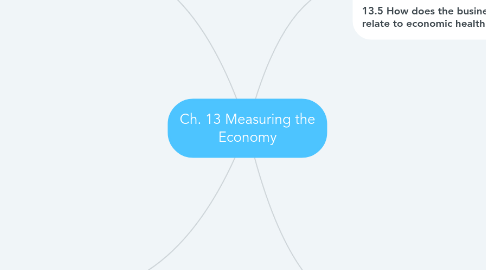Ch. 13 Measuring the Economy
by Megan Zander

1. 13.2 How do Economists measure the Economy
1.1. Gross Domestic Product (GDP)-market value of all final goods and services produced within a country during a given period of time
1.2. Economists use GDP to determine how big a country is, if the economy is growing and to compare individuals to countries.
1.3. GDP growth is the good for countries as a whole. Literacy rates are higher, health and life expectancy is better, and standard of living is higher as a result of growing GDP.
1.4. GDP is measured in four factors: Household consumption(c),business consumption (I), government purchases (G), net of exports (nx)
1.5. GDP also has several limitations such as: ignoring illegal purchases, no value on leisure time, nothing on income distribution.
1.6. informal economy- one that operates without government regulation.
1.7. net exports- the value of all exports minus all imports
2. 13.3 What does the unemployment rate tell us.
2.1. There are 4 types of unemployment: seasonal, frictional, cyclical, structural
2.2. The unemployment rate is another helpful way to measure the health of the economy.
2.3. There are still scenarios that make unemployment inaccurate: discouraged workers, involuntary par time workers, underground economy.
2.4. High unemployment is bad for the economy because of the loss of potential output, the individuals loos of income and the effect it has on society at large.
2.5. Unemployment rate-the percentage of the labor force that is seeking work.
2.6. Natural rate of unemployment-When an economy reaches full employment, jobs exist for everyone who wants to work, even though a certain percentage of those jobs and workers will not yet have been matched together.
3. 13.4 what does the inflation rate tell us about the economy.
3.1. Inflation is also something that economists watch to read the economy.
3.2. The BLS tracks inflation by gathering information from the cost of living.
3.3. In the US we have come to expect a gradual increase in inflation every year referred to as creeping inflation.
3.4. Inflation does have limitations: substitution bias, new product bias, and quality change bias.
3.5. Inflation Rate- is the percentage increase in the average price level of goods and services from one month or year to the next.
3.6. Nominal cost of living- cost in current dollars of all the basic goods and services that people need
3.7. Real cost of living-nominal cost of basic goods and services, adjusted for inflation.
4. 13.5 How does the business cycle relate to economic health
4.1. The business cycle consists of 4 phases: expansion, peak, trough, and contraction
4.2. Business cycles are irregular which makes them hard to predict.
4.3. There are 3 different types of indicators that are used to predict the cycle: Leading, coincident, and lagging.
4.4. Booms almost will always lead to busts resulting in recessions or even depressions sometimes.
4.5. Business cycle: recurring periods of growth and decline in economic activity that all economies experience.
4.6. Recession- decline in economic activity lasting at least six months.


